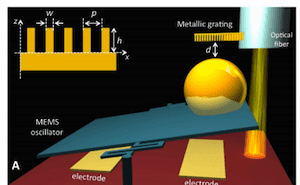
Whether or not MEMS (microelectromechanical systems) technology has use as a development path toward productive nanosystems, or atomically precise manufacturing (see for example this series of posts on the Feynman Path by J. Storrs Hall), the problem of stiction in microscale mechanical systems has been used as a canard to criticize proposals for mechanical molecular machine systems. (For why this criticism is unfounded, see section 6.3.7 of Kinematic Self-Replicating Machines.) Nevertheless, MEMS is in its own right a very useful technology so it is gratifying to see that a solution to the stiction problem may be in sight. A hat tip to Dale Amon for pointing to this physics archive blog article “US Nuclear Weapons Laboratory Discovers How to Suppress the Casimir Force“:
The Casimir effect causes microscopic machines to stick fast. Now physicists have successfully tested a way to suppress this force
The Casimir effect is a strange and mysterious force that operates on the tiniest scales. It pushes together small metal objects when they are separated by a tiny distance.
That’s a problem because engineers are increasingly interested in building tiny machines with parts that move against each other on precisely the scale. For some years now, they’ve been thwarted by a problem called stiction in which the tiny cogs, gears and other parts in these machines stick together so tightly that the device stops working.
The culprit in these strange stiction events is often the Casimir effect. But since it is poorly understood, physicists and engineers have never known how to prevent it.
That looks set to change thanks to the work of Francesco Intravaia at Los Alamos National Laboratory in New Mexico and a few pals who have discovered a way to reduce this force and showed that it works for the first time. …
The research paper “Strong Casimir force reduction through metallic surface nanostructuring” is available at arxiv.org. The authors conclude that despite their successes achieved here, a full numerical analysis of the complexities of stiction in MEMS “remains an open problem.” Fortunately we already know that this does not have to be problem in a properly designed molecular machine system, even if implemented with diamondoid parts fashioned as nanoscale versions of macroscale machine parts.
—James Lewis, PhD
